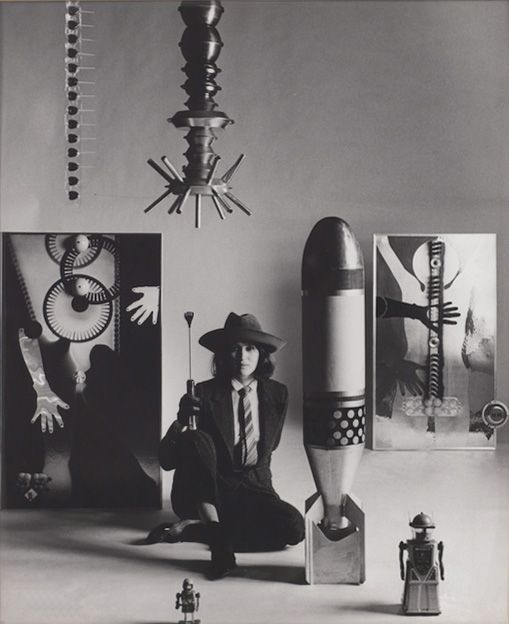It is with great pleasure that Simone Subal Gallery announces the opening of Kiki Kogelnik: Early Works, 1964 – 1970 on Sunday, September 9, 2012. The show runs until October 28, 2012. This is the first time many of the works on view have been exhibited. Please join us for the opening on Sunday, September 9, 2012 from 6 – 8 pm.
Kiki Kogelnik (1935 – 1997) studied in Vienna in the late 1950s, where her paintings were influenced by such artists as Serge Poliakoff and Karel Appel. After befriending Sam Francis during a trip to Venice, Kogelnik moved to New York in 1961. Soon after her arrival, Kogelnik made a decisive change in her practice: she gave up gestural abstraction for figurative compositions akin to Pop art.
Kogelnik ran in New York’s Pop art circles. She was friends with Claes Oldenburg and Roy Lichtenstein, and was a visitor to Andy Warhol’s Factory. Like many women of her generation she found it difficult to gain respect and attention in the male-dominated art world. Adding to this challenge was the fact that her work resisted easy classification. She produced an array of paintings and drawing built upon her belief that “art comes from artificial.” This led to her exploring the formal and conceptual possibilities of painting, drawing, sculpture, and printmaking. She also experimented with synthetic and appropriated materials to startling effect.
Kogelnik’s work from the mid to late 1960s is invested in science, technology, and the potential of the space age. Her paintings and drawings are complex meditations on pictorial surfaces, the multivalent layering of images, and societal constructions of gender. At the core of her practice is a subtle understanding of how representations shape the identity of the individual self. This recognition of the spectacular nature of contemporary culture and its impact on one’s subjectivity found correspondence in the way Kogelnik played with her self-image in a public context. She occasionally filmed herself in her studio or on the streets of New York with her 8mm camera, and attended openings and parties in a wide variety of elaborate outfits and costumes.
The three paintings and eleven drawings on view emphasize Kogelnik’s heightened sense of the complexities of representation. The paintings are generally large in composition and present flattened human figures in an atmospheric field of vibrant colors and dots. There is a quality of weightlessness to the androgynous persons, as if they experience the loss of gravity. Kogelnik derived her human forms from paper or vinyl cutouts of friends and fellow artists. In both Outer Space (1964) and Atmospheric Drag on Satellite (1965) the cutouts provide a simple and effective translation of a three-dimensional individual into a two-dimensional image.
In Outer Space and Atmospheric Drag on Satellite as well as in drawings like Female Robot (1964), Untitled (robot) (1967), and Moon (1967), Kogelnik celebrates the potential of technology, especially the optimism of space travel, but also critiques the way technology mechanizes the actions and emotions of men and women. In the late 1960s Kogelnik began to work with medical stamps of the human body. She played with the lifeless vitality of these imprints, making slight modifications to their composition in order to create an unsettling image that seems at once familiar yet foreign. Haunting these drawings, and particularly in erotic works like Sexy Afternoon (1969) and Untitled (erotic drawing) (1970), is the specter of death. Yet Kogelnik’s engagement with the finitude of existence is not a pessimistic affair, but instead, through her own distinct visual vocabulary, a profound celebration of life.
From September 15 to December 30, 2012, a comprehensive exhibition of Kiki Kogelnik’s work entitled I Have Seen The Future will be on view at the Hamburger Kunstverein, Hamburg, Germany.
Kiki Kogelnik was born in 1935 in Graz, Austria and died in 1997. She lived and worked in New York, NY; Vienna, Austria; and Bleiburg, Austria. Selected one-person exhibitions include Galerie nächst St. Stephan, Vienna, Austria (1961); the Austrian Institute, New York, NY (1965); Galerie Kornfeld, Zürich, Switzerland (1978); the BAWAG Foundation, Vienna, Austria (1983); the Kärtner Landesgalerie, Klagenfurt, Austria (retrospective), (1989); MAK – Museum of Applied Arts, Vienna, Austria (1996); and Österreichische Galerie Belvedere, Vienna, Austria (retrospective), (1998). Selected group exhibitions include the Corcoran Gallery, Washington D.C. (1965), the Fischbach Gallery, New York, NY (1965); the Kunsthaus Hamburg, Hamburg, Germany (1972); the Hirshhorn Museum and Sculpture Garden, Washington D.C. (1976), the Kunsthaus Zürich, Zürich, Switzerland (1978); the Los Angeles Institute of Contemporary Art, Los Angeles, CA (1978); the Secession, Vienna, Austria (1983); the Museum Het Paleis, The Hague, The Netherlands (1997); The Israel Museum, Jerusalem, Israel (1999); the Museum of Fine Arts, Budapest, Hungary (2001); Kunsthalle Krems, Krems, Austria (2003). Most recently, Kiki Kogelnik was featured in POWER UP – Female Pop Art at the Kunsthalle Wien, Vienna, Austria (2010) and Seductive Subversion: Woman Pop Artists 1958–1968 at the Brooklyn Museum, Brooklyn, NY (2010). In 2013 Kiki Kogelnik will have a retrospective at the Kunsthalle Krems, Krems, Austria.
















































































































